This page contains automatically translated content.
Kassel research group works on "quantum money" and quantum sensors
 Image: University of Kassel
Image: University of KasselThe diamond is supposed to function as a kind of check to be cashed by the recipient - for example, at a bank. Only the recipient can read the quantum security code; anyone else would destroy it when reading it. The researchers want to take advantage of special features of quantum mechanics by holding so-called spin states in the diamond for up to 60 seconds in special superposition states in which the spin can point up and down at the same time. In physics, spin is the intrinsic angular momentum of particles that aligns itself in the direction of a magnetic field - or in the opposite direction - much like a small compass needle. Such ambivalent spin states have so far only been possible for a few seconds. Theoretically feasible in the future could be up to 36 hours, then the diamond would be practical as a check. The system that the research group wants to develop can simultaneously function as a sensor for quantum information that is many times more sensitive than sensors used to date. The project is being supported by the Volkswagen Foundation with around 1.3 million euros.
In this project, the team from the universities of Kassel, Mainz and Erlangen-Nuremberg is making use of mechanisms of quantum physics that are difficult to reconcile with intuition at first. According to this, one and the same particle can have its spin aligned in two different directions at the same time. When observed, the spin is then fixed to one of the orientations, but then irrevocably. If one now writes certain information - for example a sequence of numbers - into a group of particles by means of quantum mechanics (one thus creates so-called quantum bits), only the one who possesses the "key", i.e. who knows how exactly the superposition state was originally created, can read out the information. Anyone else would destroy the information.
The physicists now want to inscribe the information in specially produced nanodiamonds by introducing and manipulating nitrogen ions. To do this, they are using a facility funded by the Volkswagen Foundation that is unique in the world and with which they can introduce individual ions into matter with a positional accuracy of 10 nanometers. The researchers hope to increase the quantum bits' lifespan, which has so far been limited to a few seconds, by greatly reducing the interaction of the spins with the environment and using extremely low temperatures of a few kelvins.
"If we can maintain the quantum bits for up to 60 seconds, that would be a great achievement," said Prof. Dr. Kilian Singer, head of the Light-Matter Interaction Department at the University of Kassel and coordinator of the project. "Even then, it would still be a long way to the practicality of such a means of payment, but on the other hand we would have exhausted the possibilities of quantum mechanics much further than is currently the case." Moreover, the mechanism could later be used not only for payment transactions, but also for access codes or similar applications, for example.
The research project already started in October 2016 and will run for up to six years. Of the approximately 1.3 million in support from the VW Foundation, around 1 million euros will go to the University of Kassel. In addition to Prof. Singer, Prof. Dr. Christiane Koch, Dr. Cyril Popov and Prof. Dr. Johann-Peter Reithmaier from the University of Kassel are also involved, as are Prof. Dr. Ferdinand Schmidt-Kaler from the University of Mainz and Prof. Dr. Eric Lutz from the University of Erlangen-Nuremberg.
Photos 1: Schematic of the single-ion implantation machine used to introduce nitrogen ions into the diamonds. Graphic: University of Kassel.
Download at: http://www.uni-kassel.de/uni/fileadmin/datas/uni/presse/anhaenge/2016/Bild1.png
Photo 2: Schematic representation of the diamond chip showing the color centers in different quantum states. Graphic: Uni Kassel.
Download at: http://www.uni-kassel.de/uni/fileadmin/datas/uni/presse/anhaenge/2016/Bild2.png
Contact:
Prof. Dr. Killian Singer
University of Kassel
Department of Light-Matter Interaction
Tel.: +49 561 804-4235
E-mail: ks@uni-kassel.de
Sebastian Mense
University of Kassel
Communication, Press and Public Relations
Tel.: +49 561 804-1961
E-Mail: presse[at]uni-kassel[dot]de
Internet: www.uni-kassel.de